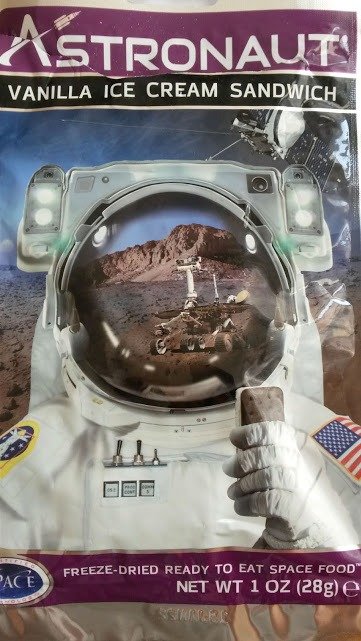Recently we’ve got to try something we wanted to sample for a long while: astronaut freeze-dried ice cream! After flashing the chalky crumbly room temperature thing down with lots of coffee and promising ourselves to never ever fly into space while that “I-scream” is on the menu, we’ve got curious. What is freeze-dried food? How do you make it? Do astronauts (or anybody else) really eat freeze-dried meals? And what about THE ICE CREAM? So..
What is freeze-drying?
Lyophylisation, or freeze-drying, is a 3 step process that consists of freezing, removing water ice and then remaining water from a product:
- Step One: freezing. This is done slowly so that the big water crystals could form. Once the crystals are removed (step 2), the big “pores” are left in their places. Later on they will be filled with water making it fast and easy to “restore” the product.
- Step Two: initial drying. This is done in a special chamber in near-vacuum. A product is dried slowly, sometimes over a few days, in low temperature. This way the ice water doesn’t melt but turns straight into gas! This process is called sublimation. Can you think of anywhere you can observe sublimation in space? That’s right, that’s how comets grow their tails!
- Step Three: sublimation takes care of about 95% of the product’s water content. The remaining water is extracted by extra drying at higher temperature.
Things to know about food freeze-drying
- No fridge needed
Freeze-dried food can keep up for years! For example, astronaut ice cream has a shelf life of 3 years, but other foods can be stored for 25 years and more.
- Expensive and energy consuming
Scientists say that, “compared with hot-air drying system and heat pump drying system, the production process of vacuum freeze-drying system is very costly and energy intensive.”
- Add water or eat straight from the packet
Some freeze-dried meals need to be rehydrated (i.e. either cold or hot water should be added), but others, like dried berries can be eaten straight from the packet.
- Preserve most vitamins and nutrients as well as shape, taste and smell
You will be surprised, but freeze-drying saves more nutrients than canning or dehydrating. For more information see the following publications:
- Not just for the astronauts
Freeze-dried food is very popular with hikers and backpackers as well as, obviously, military forces. Many people who live in areas prone to natural disasters (hurricanes, earthquakes, fires etc) use freeze-dried food as part of their emergency supply kit. There are many companies on the market, like Mountain House, Good To-Go (we love their gluten-free and vegan options) that specialize on freeze-dried meals.
Do astronauts eat freeze-dried food in space?
Yes! These days the astronauts eat a variety of food in space, from fresh to canned and freeze-dried. Freeze-dried meals were first introduced during the NASA Gemini Project missions. Originally only the cold water was used to “restore” the meals (cold space dinner – delicious!). Starting from Apollo missions, both hot and cold water became available. Now, freeze-dried food is still on the menu on the International Space Station. It tastes good, stays fresh for years and, what’s very important, it’s lightweight and therefore less expensive to deliver to the ISS!
What about that ice cream?

Interestingly, after much research, we could not find any mention of the “astronaut ice cream” ever making it into space. And no wonder. The product’s crumbly texture would have been a real hazard on board (and don’t even get us started on the taste)! Still, the astronauts enjoy ice cream deserts in orbit! Only it is a real proper ice cream, like the one you probably have in your freezer. Yummy!
Still curious?
- read WonderDome astronomy blog
- visit one of our inflatable star dome space shows
- send your space questions to our portable planetarium team

